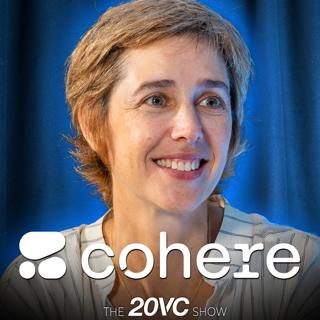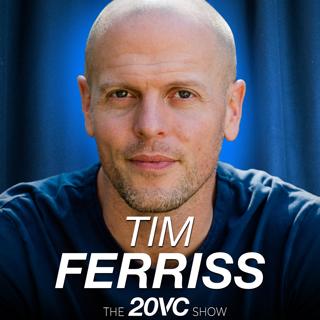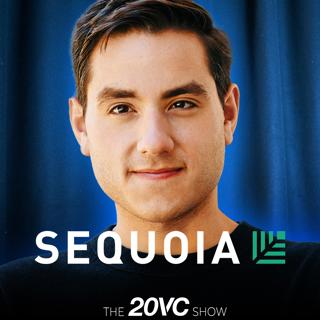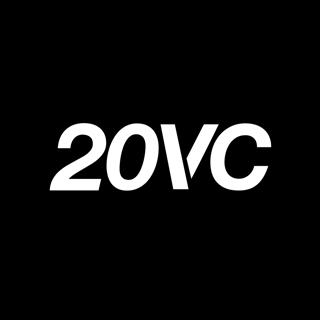
20VC: Navan IPO: Winners, Losers and is a $4.5BN Exit Enough in VC Today | Harvey Raises $150M at $8BN Price | Why Google is a Buy and Amazon is a Sell | Meta Down 10%, Is Zuck Struggling?
AGENDA: 04:27 Navan's IPO: Winners, Losers and 20% Crater 12:55 Harvey Raises $150M at an $8BN Valuation 35:36 Was Sam Altman Wrong to Snap at Brad Gerstner 41:25 Why GOOG is a Buy and Amazon is a Short 47:43 Meta Down 10%, Buy or Sell? 51:12 If You Have Not Accelerated with AI, You Are Dead 01:05:20 Why Now is the Best Time for Series A and Worst for Seed
6 Nov 1h 16min

20VC: Cohere's Chief AI Officer on Why Scaling Laws Will Continue | Whether You Can Buy Success in AI with Talent Acquisitions | The Future of Synthetic Data & What It Means for Models | Why AI Coding is Akin to Image Generation in 2015 with Joelle Pineau
Joelle Pineau is the Chief AI Officer at Cohere, where she leads research on advancing large language models and practical AI systems. Before joining Cohere, she was VP of AI Research at Meta, where she founded and led Meta AI's Montreal lab. A professor at McGill University, Joelle is renowned for her pioneering work in reinforcement learning, robotics, and responsible AI development. AGENDA: 00:00 Introduction to AI Scaling Laws 03:00 How Meta Shaped How I Think About AI Research 04:36 Challenges in Reinforcement Learning 10:00 Is It Possible to be Capital Efficient in AI 15:52 AI in Enterprise: Efficiency and Adoption 22:15 Security Concerns with AI Agents 28:34 Can Zuck Win By Buying the Galacticos of AI 32:15 The Rising Cost of Data 35:28 Synthetic Data and Model Degradation 37:22 Why AI Coding is Akin to Image Generation in 2015 48:46 If Joelle Was a VC Where Would She Invest? 52:17 Quickfire: Lessons from Zuck, Biggest Mindset Shift
3 Nov 57min

20VC: Tim Ferriss: Why I Walked Away From Angel Investing After Uber | How I Accidentally Lost $150 Million | Money Fixed My Problems—Then Made Me Miserable
🎧 20VC x Tim Ferriss — Full Episode Timeline 00:00 – "How Do You Stay True to Yourself When You Have to Perform for the World?" 06:00 – "Why Tim Ferriss Refused to Go All-In on YouTube" 09:00 – "You Don't Need 10 Million Fans—You Need 1,000 True Believers." 12:00 – "The Internet Is Not a Relevance Machine—It's a Sensationalism Machine." 15:00 – "Money Fixes Money Problems—And Nothing Else." 22:30 – "When Did Tim Ferriss Feel Completely Lost?" 27:00 – "The Million-Dollar Mistake That Still Haunts Tim Ferriss." 36:00 – "Why Tim Ferriss Never Raised a Fund—Even Though He Could Have." 45:00 – "The Truth About Uber, Duolingo, and the Power of Relationship Investing." 54:00 – "Why Tim Ferriss Stopped Angel Investing at His Peak." 1:04:00 – "The Podcast That Changed Everything." 1:15:00 – "The Real Cost of Love: Is Efficiency Killing Connection?" 1:31:00 – "What Tim Ferriss Has Changed His Mind About Most." 1:36:00 – "Erections Matter."
31 Okt 1h 31min

20VC: a16z Raises $10BN in New Funds | Mercor Raises $350M at a $10BN Valuation | OpenAI Restructuring: Who Wins and Who Loses | Why IRR is a BS Metric and Three Ways to Win in VC Today
AGENDA: 05:17 OpenAI's Restructuring: Winners and Losers 17:17 Andreessen Horowitz's Raise $10BN in New Funds 26:38 Mercor Raises $350M at a $10BN Valuation 43:08 Spray and Pray: Does it Work: Data Breakdown 47:04 The Role of Option Checks Venture Capital 48:36 The Three Ways to Win in VC Today 54:26 Why IRR is a BS Metric and What Matters More 01:08:47 Amazon's Struggles: How Do They Return to Greatness in AI
30 Okt 1h 24min

20VC: Sequoia's David Cahn on The Winners and Losers in AI | The $0-$100M Revenue Club: Is Triple, Triple, Double, Double Dead? | The Future of Defence: Who Wins and Who Loses | How to Analyse Margins and Growth Rates in a World of AI
David Cahn is a Partner at Sequoia Capital and one of the world's leading AI investors. At Sequoia David has led investments in Clay, Juicebox, Sesame, Kela, Stark, etc.. Before Sequoia, David was a General Partner @ Coatue where he led investments in Notion and Hugging Face. AGENDA: 00:00 We Are in an AI Bubble 05:04 Why Building Physical Data Centres is a Moat 13:58 Winners and Losers in a World of AI 19:13 The Role of Big Tech and Monopolies 23:37 Breaking Down Circular Deals in AI: The Truth No One Sees? 38:19 Why Kingmaking is BS and VCs Do Not Make or Break Companies 41:30 The Importance of Margins in AI Investments 43:41 The Required Growth Rates in AI to Get Funded by Sequoia 45:30 The $0-$100M Revenue Club: Is Triple, Triple, Double, Double Dead? 51:53 Why the Most Important Hire for Startups Today is 23 Year Olds 01:01:19 The Future of Defence: Who Wins and Who Loses 01:10:15 Quickfire: Biggest Miss, Parenting Advice, Doug Leone Advice
27 Okt 1h 14min

20Growth: How to Build a Paid Marketing Machine: ROAS (Return on Ad Spend) 101 | The Rise of User Generated Content and How to Use It | TikTok Ads: Expectations vs. Reality | Hiring for Growth: When and Who with Sandy Diao
Sandy Diao is one of the most exceptional growth leaders of the last decade. Sandy has scaled products to over 200M+ users and led growth teams at Descript, Meta and Pinterest. She is also a prolific writer all on things growth here. AGENDA: 03:59 Biggest Growth Lessons from Pinterest 08:01 What is a Good vs a Bad Growth Hypothesis 11:11 Common Mistakes in Growth Strategies 14:57 Channel Fit: When You Have It & What To Do 25:43 Return on Ad Spend (ROAS) 101: How to Build a Paid Marketing Machine 30:08 How to Do SEO and Long-Term Growth Investments 33:22 Doubling Down on Successful Channels 36:31 The Unchanging Foundations of SEO 37:52 Generative AI Engines vs. Traditional Search Engines 41:12 Paid Marketing Channels: What's Overrated? 43:42 The Rise of User-Generated Content (UGC) 46:34 TikTok Ads: Expectations vs. Reality 49:55 Brand Marketing: What is Real vs What is BS? 53:33 The Importance of Feature Launches 01:01:50 Hiring for Growth: When and Who? 01:08:55 Quick Fire Round: Onboarding, Notifications, and Growth Channels
24 Okt 1h 16min

20VC: Why VC Today is Worse Than 2021 | Why Vertical SaaS is a Bad Investment Today | Why We Are Deluding Ourselves on Growth Expectations | Revolut Raises $3BN at a $75BN Valuation | Benchmark Adds Their Newest General Partner
AGENDA: 04:50 Benchmark's New Partner: Everett Randall 10:19 Revolut Raises $3BN at a $75BN Valuation: Another Loss for Public Markets? 28:39 Why Today is as Bad as the Hype of COVID in 2021 32:10 Why Vertical SaaS is a Bad VC Investment Today 36:14 Why Everyone Investing in Legal SaaS Will Lose Money 44:16 Why King Making is More Real Than Ever 55:23 Why Your Smallest Customers Need to Pay $10K Minimum 01:01:37 Why VC is a S*** Asset Class 01:09:29 Why Today is Harder Than It Has Ever Been in VC 01:25:18 Closing Thoughts and Reflections
23 Okt 1h 28min

20VC: Deel CEO Alex Bouaziz on Raising $300M+ at a $17BN Valuation | Deel vs Rippling: WTF is Going On | Management Lessons from Ben Horowitz and Nik Storonsky | Deel's M&A Playbook: Lessons from 13 Acquisitions: What Works & What Doesn't
Alex Bouaziz is the Co-Founder and CEO @ Deel, the $17BN global payroll juggernaut that just last week announced their latest $300M fundraise led by Ribbit, a16z and Coatue. Deel has been on the most insane journey, they do $1BN+ in ARR, they just had their first $100M revenue month and they have been profitable for over 3 years. AGENDA: 03:38 Announcing $300M Fundraise at a $17BN Valuation 06:24 Rippling vs Deel: WTF is Going On? Where is the Lawsuit? 14:01 Why 1-1s Are BS and Leaders Should Stop Doing Them 17:31 Do Rich Leaders Make Better Leaders 28:33 Biggest Lesson from Ben Horowitz? Why Most CMOs Are Bad? 34:48 Lessons from Nik @ Revolut and Why Companies Need to Make Their Own Software 42:23 Deel's Acquisition Playbook: Lessons from 13 Acquisitions 45:17 How to Price Acquisitions? How to Align Incentives with Founders? 55:45 Deel is Profitable and Growing Fast: When is the IPO? 01:01:35 Best Acquisition Ever + Worst Ever: What Did We Learn?
22 Okt 1h 15min






















